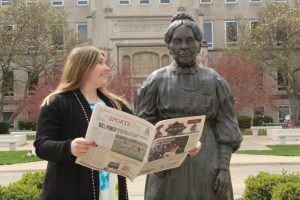Originally published November 19, 2010
When a 14-year-old student stood before the school board in defense of a teacher, he was only returning the favor.
A few weeks earlier Jay McDowell, a teacher at Howell High School in Michigan, asked one student to remove her Confederate flag belt buckle and asked two other students to leave the room after having a heated exchange about gay rights.
This wasn’t just an ordinary day, either. This was the school-wide Spirit Day, where students could participate in raising awareness about anti-gay bullying.
The First Amendment is a cornerstone of our nation. It allows us to think, say and write what we want, to believe what we believe. But at what point does someone need to step in and say enough is enough, especially in a school environment?
Technically, those students did not do anything wrong. The Howell Education Association argued that the Confederate flag belt buckle was “inappropriate or distracting” clothing, and the teacher was following protocol in asking the student to remove it.
But was the belt buckle truly any different than the students wearing purple for Spirit Day?
Obviously I can’t say for sure, but wearing the Confederate flag on Spirit Day seems to be a little more than coincidental. But the student had just as much right to wear it as anyone else did to wear purple.
As for the students who were arguing about gay rights, the Michigan American Civil Liberties Union chapter said they were probably protected by the First Amendment, as was wearing a Confederate flag belt buckle.
But just because they weren’t wrong doesn’t make it right.
In any other setting, freely stating what you think is an opportunity that should be taken advantage of. We are lucky enough to have that right in this country. But in a school, especially after the recent spike in suicides of young gay students (or at least the publicity of them,) there has to be a line drawn somewhere.
If someone is attacking a race, religion or sexual orientation in a classroom, it’s disruptive at the very least. Constructive discussion about different opinions is one thing, but blatant put-downs are another entirely.
Bullying is going to happen. It will happen in the hallways, on the bus, in the cafeteria and online. But it shouldn’t happen in the classroom, and teachers shouldn’t have to allow it during their class.
Anyone who has been through the school system knows that if someone is disrupting the class, the teacher has the authority to remove them. This is no different, even if the reasons behind it may have been.
So yes, we have the right to speak our minds, to hold fast to our beliefs and to disagree with others. And unfortunately, bullying is, to a certain degree, protected speech. But in the classroom, there’s a very fine line between the First Amendment and a student’s right to learn without being harassed.
As 14-year-old Graeme Taylor spoke before the school board, he made it clear that he and several other gay students supported McDowell’s attempt.
“There is a silent Holocaust out there, and an estimated 6 million gay people a year kill themselves,” Taylor said. “Is this really the environment we want for a school?”



